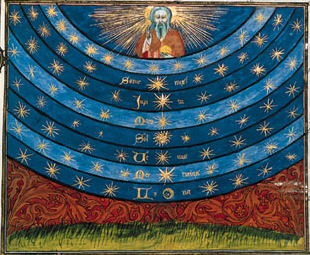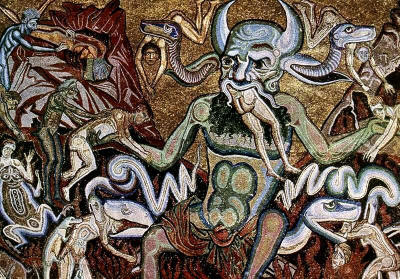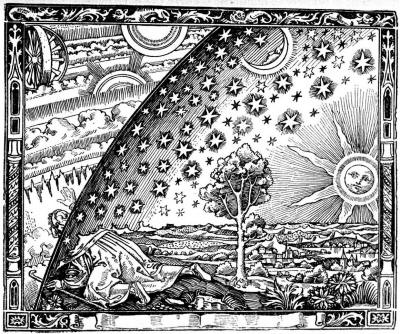|

from
Wikipedia Website

The astral spheres
were thought to be planes
of angelic existence
intermediate between earth and heaven.
This article is about a plane of
existence. In the context of Unicode, astral characters consist of
planes above the Basic Multilingual Plane.
The astral plane, also called the astral world, is a plane of
existence postulated by classical (particularly neo-Platonic),
mediaeval, oriental and esoteric philosophies and mystery religions.
It is the world of the planetary spheres, crossed by the soul in its
astral body on the way to being born and after death, and generally
said to be populated by angels, spirits or other immaterial beings.
In the late 19th and early 20th century the term was popularized by
Theosophy and neo-Rosicrucianism.
The "Barzakh" or inter-world in Islam, the "World of Yetzirah" in
Lurianic Kabbalah, the "Spirit World" in Spiritualism and the "Fairy
World" of Celtic spirituality are all related concepts.
History
Plato and Aristotle taught that the stars were
composed of a type of matter different from the four earthly
elements - a fifth, ethereal element or quintessence. In the "astral
mysticism" of the classical world the human psyche was composed of
the same material, thus accounting for the influence of the stars
upon human affairs.
In his commentaries on Plato's
Timaeus, Proclus wrote;
"Man is a little world (mikros
cosmos). For, just like the Whole, he possesses both mind
and reason, both a divine and a mortal body. He is also divided
up according to the universe. It is for this reason, you know,
that some are accustomed to say that his consciousness
corresponds with the nature of the fixed stars, his reason in
its contemplative aspect with Saturn and in its social aspect
with Jupiter, (and) as to his irrational part, the passionate
nature with Mars, the eloquent with Mercury, the appetitive with
Venus, the sensitive with the Sun and the vegetative with the
Moon."[1]

Dante's heavens and
hells
symbolized the astral
spheres and their associated virtues and vices.
Such doctrines were commonplace in
mystery-schools and gnostic sects throughout the Roman Empire and
influenced the early Christian church. Among Muslims the "astral"
world-view was soon rendered orthodox by Quranic references to the
Prophet's ascent through the seven heavens.
Scholars took up the Greek Neoplatonist
accounts as well as similar material in Hindu and Zoroastrian texts.[2]
The expositions of Ibn Sina (Avicenna), the
Brotherhood of Purity and others, when translated into Latin in
the Norman era, were to have a profound effect upon European
mediaeval alchemy and astrology. By the fourteenth century Dante
was describing his own imaginary journey through the astral spheres
of Paradise.[3]
Throughout the renaissance, philosophers, Paracelsians, Rosicrucians
and alchemists continued to discuss the nature of the astral world
intermediate between earth and the divine.
Once the telescope established that no
religious heaven was visible around the solar system, the idea was
superseded in mainstream science.
The astral
plane and astral experience
According to occult teachings the astral plane can be visited
consciously through astral projection, meditation and mantra, near
death experience, lucid dreaming, or other means. Individuals that
are trained in the use of the astral vehicle can separate their
consciousness in the astral vehicle from the physical body at will.
In early theosophical literature the term "astral" may refer to the
aether. Neo-Theosophy, as developed by Annie Besant, C.W.
Leadbeater, and later
Alice Bailey, makes the astral
finer than the etheric plane but "denser" than the mental plane. In
order to create a unified view of seven bodies and remove earlier
Sanskrit terms, an etheric plane was introduced and the term "astral
body" was used to replace the former kamarupa - sometimes
termed the body of emotion, illusion or desire.
According to Max Heindel's Rosicrucian writings, desire-stuff
may be described as a type of force-matter, in incessant motion,
responsive to the slightest feeling. The desire world is also said
to be the abode of the dead for some time subsequent to death. It is
also the home of the archangels. In the higher regions of the desire
world thoughts take a definite form and color perceptible to all,
all is light and there is but one long day.
In his book Autobiography of a Yogi, Paramhansa Yogananda
mentions the astral plane. When one dies the soul moves to the
astral plane where the result of past actions or karma is reaped.
The astral plane in
popular culture
The Astral Plane is referred to in the song Draw the Line
by Aerosmith, Dream Weaver by Gary Wright,
Legend of a Mind by The Moody Blues and in rap artist
Method Man's song Bring the Pain, which was later quoted by
rap artist 2pac in the chorus of his song "No More Pain".
The two songs Astral Plane and
Astral Plane Pt Deux by Morphine Machine are specifically about
it.
"Astral Plane" is the name of song on
the debut album of Jonathan Richman and The Modern Lovers and the
term provided the title and informed the lyrics of Van Morrison's
Astral Weeks.

"The place where
earth and heaven meet",
from Flammarion's
Popular Meteorology, 1888.
In the Marvel Universe, Doctor
Strange has practiced astral projection since his inception in
1963.
Illyana Rasputin [alias Magik]
was able to astral project her own consciousness in New Mutants
(Series 1) #15. Other mutants such as Professor X, Emma Frost, Jean
Grey, and other powerful psychics, have access to the astral plane.
Professor X imprisons the Shadow King on the astral plane. There are
beings who live there such as Cassandra Nova.
In the DC/Vertigo Universe, the Astral planes are used for travel
and magic by a certain number of individuals such as Doctor Fate,
Zatanna, and Doctor Occult, though use of astral projection is
mostly illusionary.
In the standard Dungeons & Dragons RPG planar cosmology, the Astral
Plane is a dimension coexistent with all others, used as a means of
transportation between planes. The Astral Plane is the final level
of the computer game NetHack. In Ironclaw some characters can use an
astral body.
The Apple II and PC video game Windwalker identifies the Astral
Plane as a dimension through which a character called the Alchemist
can summon demons, influence dreams and cause evil. The Astral plane
is featured as a level in the video game X-Men Legends.
In R. A. Salvatore's series of books based in the Forgotten Realms,
the main character Drizzt Do'Urden has a black panther named
Guenhwyvar who resides in the Astral Plane and is "summoned" through
a small, onyx figurine.
The Astral Plane is featured in the surreal 2000 comedy film
The Nine Lives of Tomas Katz. It is a major part of the
musical "The True Story of the Bridgewater Astral League" by The
World/Inferno Friendship Society.
It is featured in the television show
Charmed, in which it is described as a realm of "spirits and
energies".[4]
Planes of
existence
Subtle bodies
Theosophy
1. Divine plane: Deity
Spirit; Word
2. Oversoulful plane: Holy Spirit
3. Spiritual plane: Spirit
4. Soulful plane: Soul
5a. Higher mental
plane: mind
5b. Causal plane: Causal body
5c. Mental plane: body, projection
6. Astral plane: body,
projection
7a-b. Etheric-Material plane:
Ethereal body, Material body, OBE
Rosicrucian
-
The 7 Worlds & the 7
Cosmic Planes
-
The Seven-fold
constitution of Man
-
The Ten-fold
constitution of Man
Thelema
Surat Shabda Yoga
Sufism
Hinduism
Buddhism
Kabbalah
Fourth Way
Dungeons and Dragons
-
Inner Plane
-
Prime Material Plane
-
Outer Plane
References
-
Heindel, Max, The Rosicrucian
Mysteries (Chapter III:
The Visible and the Invisible Worlds),
1911, ISBN 0-911274-86-3
-
Powell, Arthur E. The Astral
Body and other Astral Phenomena
-
Steiner, Rudolph, Theosophy: An
introduction to the supersensible knowledge of the world and
the destination of man. London: Rudolf Steiner Press. (1904)
1970
-
Twitchell, Paul, "ECKANKAR - The
Key to Secret Worlds" Eckankar, 2nd Ed. 2001. ISBN
1-57043-154-X
-
Tommaso Palamidessi, Come
sdoppiarsi e viaggiare nei mondi soprasensibili, Vol. III,
ed. Archeosofica, 1989.
Notes
-
Quoted in; G.R.S.Mead, The
Doctrine of the Subtle Body in Western Tradition, Watkins
1919, page 84 (Slightly adapted).
-
The Brihadaranyaka Upanishad:
There are two states for man - the state in this world and
the state in the next; there is also a third state, the
state intermediate between these two, which can be likened
to the dream [state]. While in the intermediate state a man
experiences both the other states, that of this world and
that in the next; and the manner whereof is as follows: when
he dies he lives only in the subtle body, on which are left
the impressions of his past deeds, and of those impressions
is he aware, illumined as they are by the light of the
Transcendent Self
-
Seyyed Hossein Nasr, An
Introduction to Islamic Cosmological Doctrines, University
of New York Press, passim. Idries Shah, The Sufis, Octagon
Press, 1st Ed. 1964.
-
The Power of Three Blondes
|



